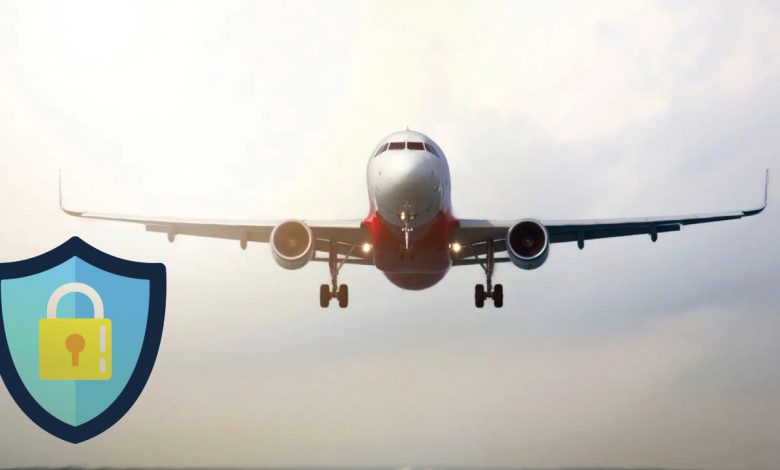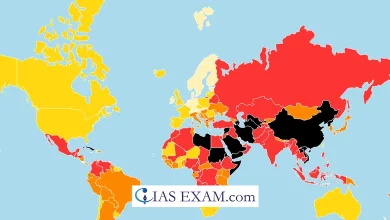Daily Current Affairs for UPSC
Aviation Safety in India
Topic- Government Policies and Interventions [GS Paper-2]

Context- In the latest rankings published by the International Civil Aviation Organisation (ICAO), India’s position has jumped to the 48th place from the 102nd spot in 2018.
Key Highlights
- The rankings are for 187 countries and assessments were done at certain points of time.
- Under its Universal Safety Oversight Audit Programme (USOAP) Continuous Monitoring Approach, an ICAO Coordinated Validation Mission (ICVM) was undertaken from the time period of November 9 to 16.
- The Effective Implementation (EI) of six areas were assessed and the areas were
- LEG is Primary Aviation Legislation and Specific Operating Regulations;
- ORG is Civil Aviation Organisation;
- PEL is Personnel Licensing and Training;
- OPS is Aircraft Operations;
- AIR is Airworthiness of Aircraft; and
- AGA is Aerodrome and Ground Aid.
- Till now for India, the ICAO has done the Coordinated Validated Mission four times, including the last one in November this year.
- It did the mission in December 2012 which covered all the areas and the EI score rose from 79.84% to 81.32%.
- The mission was later conducted in August 2013 that looked at two areas – OPS and AIR. At that time, the score improved from 79.73% to 81.19%.
- Another mission was conducted in November 2018 and it covered LEG, ORG, AIG, ANS and AGA. During that time, the EI score declined from 71.86% to 69.95%.
- The ICAO looks at the eight core elements for the safety oversight system, thar includes primary aviation legislation, specific operating regulations, resolution of safety issues and surveillance obligations.
- With a score of 85.49% each, India and Georgia are placed at the 48th position.
- Neighbouring Pakistan’s score is 70.39%.
- The rankings are topped by the country Singapore with a score of 99.69%.
- It is followed by the UAE at the second position with a score of 98.8% and the Republic of Korea is at the third place with a score of 98.24%.
- Other countries in the top ten are France (4th; 96.42%), Iceland (5th; 95.73%), Australia (6th; 95.04%), Canada (7th; 94.95%), Brazil (8th; 94.72%), Ireland (9th; 94.6%) and Chile (10th; 93.9%), as per the DGCA officials.
- The ranking, which places India ahead of China (49), is the highest ever received by India.
- The country’s aviation sector is slowly coming back into the growth trajectory after being severely hit by the COVID-19 pandemic, and the domestic air traffic is inching towards the pre-pandemic level.
Aviation Sector in India
-
- India has one of the fastest growing aviation markets in the world.
- Its domestic traffic makes up 69% of the total airline traffic in the South Asian region.
- India’s airport capacity is expected to handle 1 billion trips annually by 2023.
- The Ministry of Civil Aviation has the responsibility of formulating national aviation policies and programmes.
- Airports Authority of India (AAI):
- The authority is responsible for creating, upgrading, maintaining and managing civil aviation infrastructure in the country.
- As on June 23, 2020, the AAI operates and manages 137 airports in the country.
- It has leased out eight of its airports through Public Private Partnership (PPP) for operation, management and development on a long term lease basis.
-
Regional Connectivity Scheme (RCS-UDAN):
-
- The top 15 airports in India account for about 83% of the total passenger traffic.
- These airports are close to their saturation limit, and hence the Ministry notes that there is a need to add more Tier-II and Tier-III cities to the aviation network.
- The Regional Connectivity Scheme was introduced in 2016 in order to stimulate regional air connectivity and make air travel affordable to the masses.
- The budget for this scheme is allocated worth Rs 4,500 crore over five years from 2016-17 to 2021-22.
- As of December 16, 2021, 46% of this amount has been released. In 2022-23, the scheme has been allocated Rs 601 crore, which is 60% lower than the revised estimates of 2021-22 (Rs 994 crore).
Challenges
- Maintaining
-
-
- The challenge now is to maintain and further improve the air safety ecosystem in the country.
- Finance:
- The aviation sector came under serious financial stress during the Covid-19 pandemic.
- After air travel was suspended in March 2020, airline operators in India reported losses worth above Rs 19,500 crore while airports reported losses worth more than Rs 5,120 crore.
- Congestion at Airports:
- Domestic air traffic has more than doubled from about 61 million passengers in 2013-14 to around 137 million in 2019-20.
- International passenger traffic has grown from 47 million in 2013-14 to around 67 million in 2019-20, registering a growth of more than 6% per annum.
- As a result, airports in the country are witnessing rising levels of congestion.
- Major airports are operating at 85% to 120% of their handling capacity.
-
- Availability of Resources:
-
-
- Lack of availability of land and creation of regional infrastructure has led to delays in the implementation of Regional Connectivity Scheme (RCS-UDAN).
- Certain issues with obtaining licenses and unsustainable operation of awarded routes also contribute to the delay.
- Capacity and infrastructure:
- Due to the rapid expansion, airspace, parking bays and runway slots will become scarce over the next few years,
- Skilled labour
- According to a study conducted by the Ministry of Civil Aviation, Indian aviation could directly support 1.0 to 1.2 million employment by 2035.
- This means that about 0.25 million persons will need to be skilled over the next 10 years.
- But there is a shortage and gaps in availability of industry recognised skills.
-
- High cost to passengers and of air cargo:
-
-
- The government has mandated that all airports move from a single to a hybrid till structure which raises costs for airlines and passengers.
- Due to high taxes and lack of competition among providers, ATF is expensive in India. It is also outside the ambit of GST which creates a high regional disparity in its price.
- Incidence of GST on Aircraft Leases and Spare Parts also raises cost for the sector.
- Profitless Growth:
- Rising aviation turbine fuel cost, slowdown in capacity addition, and decline in the value of rupees are leading to a scenario of Profitless Growth.
- Aviation safety:
- Although, the number of aviation safety violations in 2017 (337) has decreased in comparison to 2016 (442), the absolute number still remains high.
- Security and Terrorism:
- Rising global terrorism and airports have become major targets of terrorist groups.
- Lack of Draft Passengers Charter:
- In the absence of such draft, adequate services to passengers cannot be ensured.
-
- Rising cost of Aviation Turbine Fuel:
-
- The cost of Aviation Turbine Fuel (ATF) accounts about 40% of the total operating cost of airlines and impacts their financial viability.
- ATF prices have been consistently growing over the past years, placing stress on the balance sheets of airline companies.
- As per recent reports, airfares are expected to rise as the conflict between Russia and Ukraine is making ATF costlier.
Way Forward
- The Government needs to go for privatisation of some airports to address the problem of congestion.
- ATF needs to be included within the ambit of GST and that applicable GST should not exceed 12% on ATF with full Input Tax Credit.
International Civil Aviation Organisation (ICAO)
-
- ICAO is funded and directed by 193 national governments in order to support their diplomacy and cooperation in air transport as signatory states to the Chicago Convention (1944).
-
Objective
- Its objective is to achieve the sustainable growth of the global civil aviation system.
- It aims to serve as the global forum of States for international civil aviation. ICAO develops policies and Standards, undertakes compliance audits, performs studies and analyses, provides assistance and builds aviation capacity through many other activities and the cooperation of its Member States and stakeholders.
-
Functions:
-
- To maintain an administrative and expert bureaucracy (the ICAO Secretariat) supporting these diplomatic interactions
- To research new air transport policy
- Standardisation innovations as directed and endorsed by governments through the ICAO Assembly, or by the ICAO Council which the assembly elects.
- In addition to these core diplomatic and research capabilities, ICAO also serves as a critical coordination platform in civil aviation through its seven Regional Offices.





.png)



